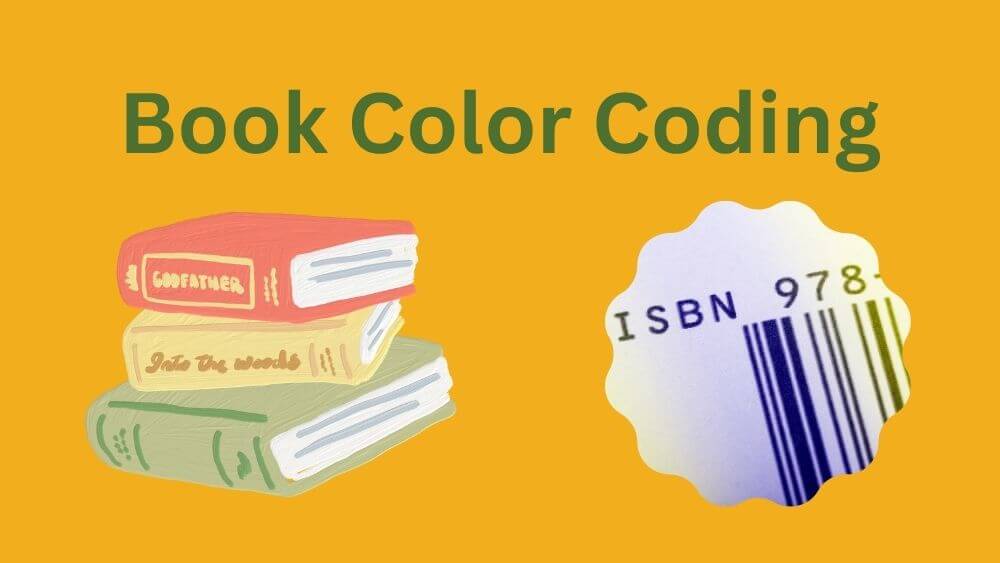Introduction
At a time of increasing digital media use and screen distraction, nothing beats flipping through physical books for their unique charm.
Books hold a special place in our hearts whether we are avid readers, students, or collectors; each holds its own significance for us all.
But have you ever considered the significance of colors on book spines and covers?
Welcome to book color coding: an intriguing but often neglected aspect of literary culture! In this comprehensive guide, we’ll delve deep into the purpose, history, and practical applications of book color coding!

Understanding Book Color Coding
What Is Book Color Coding?
Book color coding is the practice of assigning specific colors to books or book categories to convey information or create a visual system for organizing and identifying them.
It’s an ingenious way to navigate your personal library or a bookstore effortlessly.
The Origins of Book Color Coding
Color coding of books dates back to ancient libraries and monasteries, where scribes used colors to categorize manuscripts into categories and organize them alphabetically.
More recently, libraries and publishers adopted color-coding systems to increase the accessibility and aesthetic appeal of their publications.
The Purpose of Book Color Coding
Organizing Your Library
One of the primary purposes of book color coding is to help organize your library efficiently.
By categorizing books by color, you can quickly locate the genre, subject, or author you’re looking for.
Enhancing Aesthetics
Bookshelves adorned with color-coded books create a visually pleasing and harmonious display.
The aesthetic appeal of such arrangements adds charm to any room.
Facilitating Quick Selection
Color-coded books allow for quick and intuitive book selection.
Whether you’re in a rush or just browsing, a glance at the colors can guide you to your desired reading material.
Personalized Reading Journeys
Many readers use book color coding as a means to curate their reading experiences.
They might assign specific colors to books they want to read, have already read, or plan to revisit, creating a personalized reading journey.
Book Color Coding Systems
Genre-Based Coding
One of the most common approaches is to assign different colors to various literary genres.
For instance, mystery novels might be denoted by a dark blue spine, while romance novels could have a pink one.
Author-Centric Coding
Some book collectors prefer to assign colors based on the author’s name.
This method simplifies finding books by favorite authors and adds a personal touch to their shelves.
Subject-Matter Coding
In academic or reference libraries, subject-based coding is prevalent.
Each subject area gets a specific color, making locating relevant texts easier for students and researchers.
Chronological Coding
In historical or biographical collections, chronological coding can be used.
Books from different periods may be assigned distinct colors for easy identification of historical context.
Creating Your Book Color Coding System
Step 1: Define Your Categories
Start by determining the categories that matter most to you. Are you organizing by genre, author, subject, or another criterion? List them out.
Step 2: Choose Your Colors
Select colors that resonate with each category. Consider using a variety of shades within each color to create a visually appealing gradient.
Step 3: Apply Labels or Stickers
To maintain the integrity of your books, avoid writing directly on them. Instead, use labels or stickers with corresponding colors and category names.
Step 4: Create a Reference Guide
Craft a reference guide or key that associates colors with their respective categories. This will be a handy tool as your collection grows.
Frequently Asked Questions
Can I change my book color coding system later?
Yes, book color coding is flexible. You can modify your system as your collection evolves or your preferences change.
Should I color-code all my books?
It’s entirely up to you. Some people choose to color-code their entire collection, while others only code specific genres or categories.
What if a book fits into multiple categories?
If a book belongs to multiple categories, you can either choose one primary category or use a combination of colors to represent all relevant categories.
Is there a universal book color coding system?
No, there’s no one-size-fits-all system. Book color coding is highly personal, and the system you create should cater to your unique needs and preferences.
Conclusion
Book color coding is more than just an effective way to organize your library; it’s an art form in its own right!
From collecting to school textbooks, book color coding offers something new for every bibliophile or student out there!
So grab your books, select the hues you prefer, and begin your adventure deciphering literature’s beauty through color!
Book color coding adds an extra element of joy and wonder to reading and collecting books, reminding us that literature exists across a spectrum of colors that extends far beyond our bookshelves.
